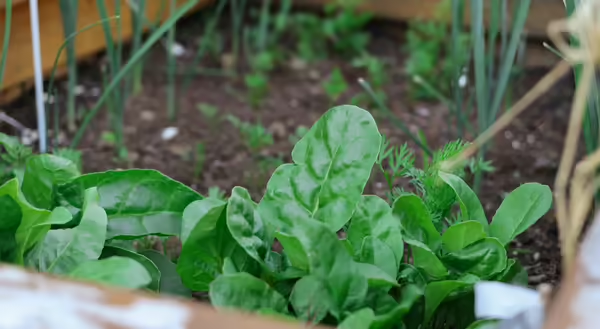
A fall vegetable garden offers a fresh start.
Cool-season vegetables like leafy greens, root crops, broccoli, and cabbage—commonly grown in spring—get a jumpstart when planted in the warm soils of late August. Plant cool-season crops in a sunny area with well-draining soil.
With regular watering and weeding, the cool temperatures of September and October will promote healthy (delicious) plant growth.
Leafy greens
Lettuce, spinach, and arugula perform poorly in the heat of summer, but are ideal for fall, preferring temperatures between 45°F to 75°F, according to Michigan State University Extension. Their preference for cool weather coupled with a quick growth rate makes leafy greens the bookends of a growing season: when eating with the seasons, they are the first harvest in April and are the grand finale in fall. Just like in spring, fall season extenders (row covers and cold frames) can extend the growing window for this leafy green by protecting it from early frost. Direct seed in August and savor a second season of salad with leafy greens.
Asian greens
Bok choy, tatsoi, and mizuna, are gaining popularity with Midwestern consumers as a green that is great in salads, stir-fries, and soups. More cold-tolerant than leafy greens, according to Oregon State University, this group of cool-season vegetables does well when direct-seeded in late August or early September. With an ability to endure light frosts, Asian greens extend the salad season into the early winter months.
Root vegetables
Carrots, radishes, turnips, and beets are hardy crops that withstand cold temperatures and grow sweeter with a light frost. To ensure a timely harvest, look for varieties with a short ‘days-to-maturity’ and plant in August. For optimal growth and development, loosen soil and amend with compost; water and weed during establishment; thin young seedlings; and mulch to hold moisture. Mature carrots can remain in the ground under heavy mulch and be harvested until the ground freezes hard.
Cole crops
Broccoli, cauliflower, cabbage, and kale thrive in fall weather when transplanted in late August. According to South Dakota State University Extension, cole crops, or cruciferous vegetables, are frost-hardy and tolerate below-freezing temperatures (mid-20s). In fact, the freezing weather improves their flavor! If starting plants from seed, start them in mid-to-late July for mid-August planting – a goal for vegetable garden 2024.
Late summer is an excellent time to get your hands in the soil.
Select suitable varieties of cool-season vegetables and employ proper planting and care techniques to enjoy a bountiful harvest from fall to early winter.
For more knowledge, learn to grow a fall root crop.
Photo Credit: Photo by Sigmund on Unsplash
ABOUT THE AUTHOR: Nick Frillman is a Local Foods and Small Farms Educator serving Livingston, McLean, and Woodford Counties. A fourth-generation graduate from University of Illinois, Frillman has a B.A. with a double major of Political Science and Spanish and a M.S. in Crop Science with a focus on crop production. Before joining Illinois Extension, Frillman completed a field season of CSA and farmers’ market-style production at a small “beyond-organic” vegetable farm in Sandy, Oregon.
ABOUT THE EDITOR: Liz Repplinger is the Agriculture and Natural Resources Program Coordinator serving Livingston, McLean, and Woodford Counties. A Bloomington-Normal native, Liz earned a B. A. in Animal Science and an M.S. in Animal Science from Illinois State University. She has enjoyed contributing to the multiple facets of Extension including previous support of the 4-H Youth Development Program as a program coordinator and current support of Unit and Statewide Diversity, Equity and Inclusion Initiatives.